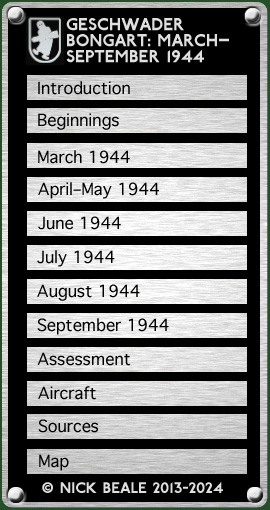|
Military Commander South West France ordered to take action against young French pedestrians on roads. Those without papers to be handed over to working parties or Security Police. Special Staff z.b.V. General Theissen charged with relentless execution of the above. ULTRA XL 3061 The Geschwader put up three aircraft in response to reports of Resistance concentrations around Nantiat, about 20 km NNW of Limoges. A Go 145 in the air from 09.02–11.26 hrs. reported several lorries cars and motorcycles on roads west of the village, some with drivers in khaki uniforms. The drivers of one group had taken cover when the aircraft approached. Just over an hour after the Gotha landed, a pair of Re. 2002 set out to bomb and strafe these columns but it seems that they were unable to find them and they returned at 14.27 hrs. At Verclause (58 km SE of Montélimar), Resistance fighters ambushed a German convoy in an exchange of fire lasting two hours. Two aircraft appeared and the Germans spread out a flag (or recognition panel?) which failed to prevent both aircraft shooting up the column and hitting a number of their own people. By now III./SG 4 had accumulated 49 aircraft at Clermont. According to Jean-Bernard Frappé’s account, it was around now that Maj. Weyert was told to prepare to transfer his operational aircraft to Conches, the Gruppe having been ordered on the 21st to look at the possibilities of operating from this area. There is more than one “Conches” in France but Conches-en-Ouche, a town in Upper Normandy, about 16 km south west of Évreux, seems the most likely since it lies right alongside the German-built aerodrome of Le Fresne which seems to have been an important repair and maintenance facility. 24 June Two Geschwader Bongart Re. 2002s flew an armed reconnaissance around Nantiat from 08.42–10.30 hrs. The IV. Gruppe reported that it was ferrying Ju 88 A-4 W.Nr. 3808 to the Junkers factory at Leipzig-Mockau. The 10. Staffel (still at Aix-L’Enfant) was told to be ready to transfer to Luxeuil immediately if so advised. This message was addressed from “Kommodore Geschw. Bongart” to 10./Fliegerzielgeschwader 2, which Bletchley Park took as confirmation that Bongart’s unit and FZG 2 were one and the same. The Geschwader reported the following strength in aircraft:
Workshops at Dreux were asked to prepare some of III./SG 4’s Fw 190s for ferrying to Clermont-Ferrand and the 9. Staffel transferred seven of its aircraft to Avord, 150 km distant. (Avord Farges-en-Septaine aerodrome is just 14 km east of the airfield at Bourges). 25 June The 12. Staffel was busy trying to locate some of its aeroplanes, asking Villaroche Air Movement Control (presumably Melun-Villaroche, just south east of Paris) for an urgent report on aircraft SF+UN and its probable take-off time for Châteauroux. The reply was that after arriving two days earlier, it had left for Villacoublay-South that morning. Biarritz was likewise urgently asked for a landing report of a W.34, DH+DV, and its anticipated take-off for Châteauroux. Avord was raided by an estimated 70 American heavy bombers from 06.25–06.35 hrs. Between 250 and 300 hits were reported on the landing area and 120 on the runways, two hangars were destroyed and the airfield lighting was put out of action. It was thought that it would take two or three days to restore even a limited area to serviceability and delayed action bombs were impeding the repair work. In the south western Département of Lot-et-Garonne, German troops hoping to flush out the Bataillon Arthur used flame-throwers to set fire to the pine forest near Lestaget, along the Allons–Sauméjean road. The guerillas had established their own fire break and constructed a camouflaged position beside the Ciron, a tributary of the River Garonne: Far off we hear the throbbing of rapidly-approaching aeroplanes. We had the impression that we were risking a visit by the German airforce. The whole group have understood and taken their places in the hollow of the Ciron, we know this is meant for us. 10.00 hrs. [local]: two German planes are in view. No doubt, they’re looking for us … nothing moves around Lestaget … Visibility must be bad for the airmen. The first volleys are fired at random … they’ve aimed at the Ciron. From up there they must be seeing the smoke, the … fires and the green line of the river. During the first run a burst passed very close to our explosives cache [and] they came round again to favour us with lovely sticks of bombs. Nobody has been hit. 26-27 June 1944 At first light, Hptm. Werner Dedekind, Kapitän of 7./SG 4, led 12 machines on a transfer flight from Clermont, bound for Conches. Shortly before arriving, the formation ran into Allied fighters and so landed at Villacoublay. One Fw 190, damaged by gunfire, crash-landed at Conches. Although the Gruppe was placed at two hours’ readiness it is not clear that any operations were flown. Avord reported that there were now eleven of 9./SG 4’s aircraft there, along with two officers and nine men (presumably the pilots). Fliegerzielgeschwader 2 meanwhile reported the destruction of an Re. 2002 on 26 June and damage to a Bf 109 the following day. Both incidents were listed as human error and neither aircraft was on a non-operational flight. On 27 June, Ergänzungsstaffel/KG 66 signalled that both Avord and Bourges would be unserviceable for about a week. Bad weather that day precluded operations, affording III./SG 4 a rest day. At 23.30 hrs. Fliegerkorps X told I./KG 40 that it was to provide two aircraft for leaflet dropping on behalf of Army Group G, apparently in the Toulouse area. The I./KG 40 was equipped with the He 177 which seems perhaps a little over-specified for such a task. continued on next page …
|
||||||||||||||||||||||||||||||||||||||

